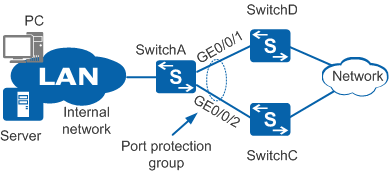Configuring Port Protection
Context
Hosts are usually connected to an external network through a default gateway. If the outbound interface of the default gateway fails, the hosts cannot communicate with the external network, interrupting normal service transmission and degrading device reliability. The port protection function solves this problem. Without changing the networking, you can add two interfaces on the device to a port protection group to implement interface backup in active/standby mode. When the active interface fails, services are immediately switched to the standby interface, ensuring non-stop service transmission.
As shown in Figure 1, the port protection group configured on SwitchA contains an active interface GE0/0/1 and a standby interface GE0/0/2. The active interface GE0/0/1 transmits service data when it works properly. When the active interface fails and goes Down, the system automatically switches services to the standby interface GE0/0/2. This switchover ensures normal service transmission and improves device reliability.
After the standby interface GE0/0/2 takes over service transmission, the services will not be switched back to GE0/0/1 even if GE0/0/1 is recovered. The services are switched back to GE0/0/1 only when GE0/0/2 fails.
Procedure
- Run system-view
The system view is displayed.
- Run port protect-group protect-group-index
A port protection group is created and the port protection group view is displayed.
- Run protect-group member interface-type interface-number master
The active interface in the port protection group is configured.
- Run protect-group member interface-type interface-number standby
The standby interface in the port protection group is configured.
A port protection group contains only an active interface and a standby interface.

To improve service switchover performance of interfaces in a port protection group, you can run the carrier { up-hold-time | down-hold-time } interval command on the active and standby interfaces to set the delay in reporting status changes to 0 milliseconds. This configuration ensures that the system immediately switches services to the standby interface when the active interface fails.
